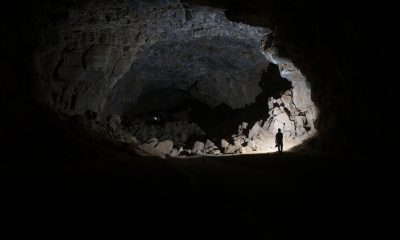Some of the first British people were cannibals
Researchers explored DNA from a female and male who both lived more than 13,500 years ago.
Published
1 year ago onBy
Talker News
(Ground Picture via Shutterstock)
By Stephen Beech via SWNS
Some of the first Britons were cannibals but not all of them, reveals ground-breaking new research.
Analysis of the UK’s oldest human DNA obtained from the remains of people who lived in caves over 13,000 years ago indicates the presence of two groups, with "distinct" origins and cultures, that migrated to Britain at the end of the last Ice Age.
And one of those groups who lived in Gough’s Cave in Somerset, UK, practiced ritualistic cannibalism, according to the report.
But there is no evidence that the other group, based in present-day Wales, were cannibals.
Researchers explored DNA evidence from a female found at Gough’s Cave, and a male from Kendrick’s Cave in North Wales, who both lived more than 13,500 years ago.
Very few skeletons of that age exist in Britain, with around a dozen found across six sites in total.
The pioneering research, which involved radiocarbon dating and analysis as well as DNA extraction and sequencing, has shown that it is possible to obtain useful genetic information from some of the oldest human skeletal material in the country.
The study, published in the journal Nature Ecology and Evolution, was conducted by scientists from University College London's Institute of Archaeology, the Natural History Museum and the Francis Crick Institute in London, UK.
They explained that the genome sequences now represent the earliest chapter of the genetic history of Britain - but ancient DNA and proteins promise to take us back even further into human history.
The team said that DNA from the Gough’s Cave female, who died about 15,000 years ago, indicates that her ancestors were part of an initial migration into northwest Europe around 16,000 years ago.
However, the individual from Kendrick’s Cave is from a later period, around 13,500 years ago, with his ancestry from a western hunter-gatherer group.
The researchers say that the group’s ancestral origins are thought to be from the near East, migrating to Britain around 14,000 years ago.
Study co-author Dr. Mateja Hajdinjak, of the Francis Crick Institute, said: “Finding the two ancestries so close in time in Britain, only a millennium or so apart, is adding to the emerging picture of Palaeolithic Europe, which is one of a changing and dynamic population.”
The researchers noted that those migrations occurred after the last Ice Age when around two-thirds of Britain was covered by glaciers.
As the climate warmed and the glaciers melted, "drastic" ecological and environmental changes took place and humans began to move back into northern Europe.
Co-author Dr. Sophy Charlton said: “The period we were interested in, from 20,000 to 10,000 years ago, is part of the Palaeolithic – the Old Stone Age.
"This is an important time period for the environment in Britain, as there would have been significant climate warming, increases in the amount of forest, and changes in the type of animals available to hunt.”
As well as genetically, the team said that the two groups were found to be "culturally distinct," with differences in what they ate and how they buried their dead.
Co-author Dr. Rhiannon Stevens, of UCL's Institute of Archaeology, said: “Chemical analyses of the bones showed that the individuals from Kendrick’s Cave ate a lot of marine and freshwater foods, including large marine mammals.
“Humans at Gough’s Cave, however, showed no evidence of eating marine and freshwater foods, and primarily ate terrestrial herbivores such as red deer, bovids - such as wild cattle called aurochs - and horses.”
The research team also discovered that the mortuary practices of the two groups also differed. Although there were animal bones found at Kendrick’s Cave, those included portable art items, such as a decorated horse jawbone.
No animal bones were found that showed evidence of being eaten by humans, and the scientists say that indicates the cave was used as a burial site by its occupiers.
In contrast, animal and human bones found in Gough’s Cave showed "significant" human modification, including human skulls modified into "skull-cups" - which the researchers believe to be evidence of ritualistic cannibalism.
They said individuals from that earlier population seem to be the same people who created the Magdalenian stone tools, a culture known also for iconic cave art and bone artifacts.
Gough’s Cave is also the site where Britain’s famous Cheddar Man was discovered in 1903, dating to around 10,000 years ago.
Cheddar Man was found to have a mixture of ancestries, mostly (85 percent) western hunter-gatherer and some (15 percent) of the older type from the initial migration.
Co-author Dr. Selina Brace, of the Natural History Museum, added: “We really wanted to find out more about who these early populations in Britain might have been.
“We knew from our previous work, including the study of Cheddar Man, that western hunter-gatherers were in Britain by around 10,500 years Before the Present but we didn’t know when they first arrived in Britain, and whether this was the only population that was present.”
The human remains from Kendrick’s Cave are on display at Llandudno Museum and those from Gough’s Cave at the Natural History Museum.
Stories and infographics by ‘Talker Research’ are available to download & ready to use. Stories and videos by ‘Talker News’ are managed by SWNS. To license content for editorial or commercial use and to see the full scope of SWNS content, please email [email protected] or submit an inquiry via our contact form.
You may like


Study claims having this type of job can reduce risk of memory issues


Study claims AI better than doctors in accurately assessing eye problems


Remains of possibly largest marine reptile ever found on beach by girl


7 out of 10 teens on Twitter get bullied over their weight


Early humans used lava cave to shelter from elements 7,000 years ago


New method heals broken bones quicker and may make them stronger
Other Stories


Study claims having this type of job can reduce risk of memory issues
A research team measured the degree of cognitive stimulation while working.


Study claims AI better than doctors in accurately assessing eye problems
Are eye doctors going to get replaced by A-eye?


Remains of possibly largest marine reptile ever found on beach by girl
She made the "amazing" discovery while searching for fossils on a beach.


7 out of 10 teens on Twitter get bullied over their weight
Twitch was the second-highest social media platform linked to weight-related bullying.


Early humans used lava cave to shelter from elements 7,000 years ago
They used the shelter from the fierce desert sun.
Top Talkers

 Food & Drink1 week ago
Food & Drink1 week agoWe eat enough grilled cheeses a year to fill 900 Olympic swimming pools

 Broadcast1 week ago
Broadcast1 week agoOver 50% of Americans trust Google more than their schooling

 Animals1 week ago
Animals1 week agoAdorable Australian is a 4-year-old ‘wombat whisperer’

 Broadcast1 week ago
Broadcast1 week agoAmericans eat enough grilled cheeses a year to fill 900 Olympic swimming pools

 Broadcast7 days ago
Broadcast7 days agoGrocery shopping hungry is costing Americans this much
- Broadcast1 week ago
Why 3 in 4 prefer road trips over flying

 Broadcast2 days ago
Broadcast2 days agoOver 40% of Americans have no clue what a 401k is

 Funny7 days ago
Funny7 days agoCops confused by crow mimicking police siren
